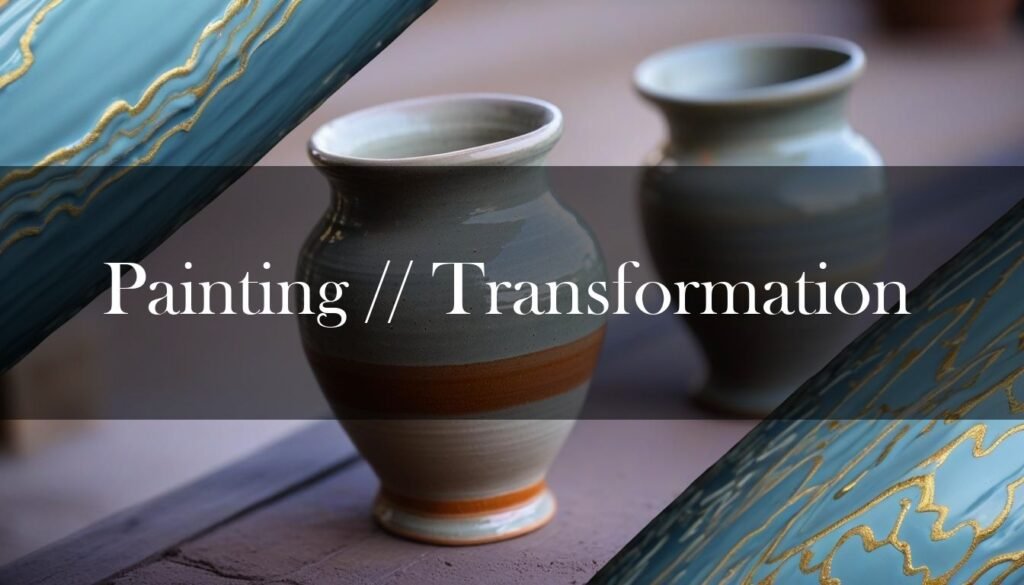Have you ever looked at a sleek glass vase and thought, “If only this had the rustic charm of pottery?” Well, you’re in luck! With a few clever techniques and the right materials, you can transform ordinary glass into stunning pieces that mimic the look and feel of handcrafted pottery.
The first step is choosing the right paint. Acrylic enamel paints are fantastic for glass because they offer great adhesion and a durable, glossy finish. Oil-based enamels are another excellent option, known for their hard, long-lasting finish. If you’re aiming for a translucent effect, specialized glass paints can be heat-set to become dishwasher safe. Don’t forget spray paints formulated for glass for covering larger areas evenly, or acrylic paint markers for detailed designs.
Remember, preparation is key! Clean the glass thoroughly and consider lightly sanding the surface to improve paint adhesion. Curing the painted item in an oven at around 300°F (150°C) for about 30 minutes can significantly enhance its durability.
Read more about paint types for glass here.
But pottery isn’t just about the color; it’s about the texture! Creating a textured surface on glass before painting can truly elevate your project. Sandpaper can be used to abrade the glass, starting with a coarser grit like 400 and moving to a finer grit like 600 for a more refined texture. For a more dramatic effect, consider acid etching, which involves applying an acid-based cream to create a frosted look. Sandblasting is another option, using high-pressure air mixed with abrasive materials to erode the glass surface. You can even mimic traditional glassmaking techniques to add unique tactile qualities. Alternatively, specialized textured paints or even applying materials like glass powders or enamels can create stunning effects.
Check out this great video on glazing techniques for pottery:
More information on prepping glass surfaces with sandpaper here, and more about traditional glassmaking techniques here.
“Creating a textured surface on glass before painting can truly elevate your project.”
To truly capture the essence of pottery, consider achieving a matte finish. Frosted glass spray paints are a simple solution, providing a uniform, non-shiny surface. You can also use matte acrylic paint combined with gesso, a primer that helps the paint adhere to the glass. Chalked spray paints offer a chalky, matte finish, perfect for a rustic look. Another cool trick involves mixing Mod Podge with food coloring to create a frosted effect. Pour the mixture into the glass, swirl it around, and bake it for a unique, homemade touch. For a temporary effect, you can even use milk, applying a layer with a paint roller and letting it dry overnight!
Read more about achieving a matte finish here, and more about chalked spray paints here.
- Frosted glass spray paints are a simple solution.
- Matte acrylic paint combined with gesso can be used.
- Chalked spray paints offer a chalky, matte finish.
- Mixing Mod Podge with food coloring can create a frosted effect.
- For a temporary effect, you can even use milk!
“To truly capture the essence of pottery, consider achieving a matte finish.”
To really sell the aged pottery look, distressing techniques are your best friend. Try layering dark gray or black chalk paint with white or off-white latex paint, then gently rub away areas to reveal the darker base coat. A stain or gel stain can add further depth and an aged appearance. Another method involves creating a mud-like texture with soil and water, coating the vase, and then rubbing off the excess. You could also use tissue paper and Mod Podge to create wrinkles and bumps, then paint over it with white chalk paint, followed by a “salt paint” made with Plaster of Paris, water, acrylic paint, and kosher salt for a truly unique, aged effect.
Read more about making a new vase look old here, creating an aging effect on vases here, and a super easy trick to turn a glass vase into vintage pottery here.
Distressing Techniques:
Layer dark and light paints.
Use stain or gel stain.
Create a mud-like texture.
Apply tissue paper and Mod Podge.
Finally, if you plan to use your painted glass for serving food, it’s essential to use a food-safe sealant. Food-grade silicone sealants are excellent choices, as they are FDA approved for incidental food contact. Always follow the manufacturer’s instructions for application and curing to ensure optimal results and maintain food safety standards.
More information on food-grade silicone sealants here.
With these tips and techniques, you can transform ordinary glass vases into beautiful, pottery-inspired pieces that add a touch of rustic elegance to your home. Happy crafting!





